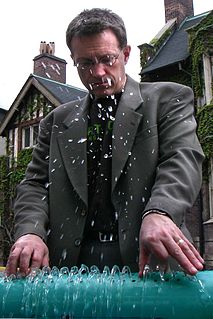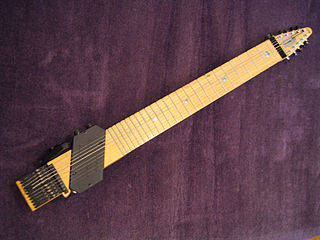Related Research Articles

The classical guitar is a member of the guitar family used in classical music. An acoustic wooden string instrument with strings made of gut or nylon, it is a precursor of the modern acoustic and electric guitars, both of which use metal strings. Classical guitars are derived from the Spanish vihuela and gittern in the fifteenth and sixteenth century, which later evolved into the seventeenth and eighteenth-century Baroque guitar and later the modern classical guitar in the mid-nineteenth century.
A mandolin is a stringed musical instrument in the lute family and is generally plucked with a plectrum. It most commonly has four courses of doubled metal strings tuned in unison, thus giving a total of 8 strings, although five and six course versions also exist. The courses are typically tuned in an interval of perfect fifths, with the same tuning as a violin. Also, like the violin, it is the soprano member of a family that includes the mandola, octave mandolin, mandocello and mandobass.

String instruments, stringed instruments, or chordophones are musical instruments that produce sound from vibrating strings when a performer plays or sounds the strings in some manner.

Zither is a class of stringed instruments. Historically, the name has been applied to any instrument of the psaltery family, or to an instrument consisting of many strings stretched across a thin, flat body. This article describes the latter variety.
The music of Arizona began with Indigenous music of North America made by Indigenous peoples of Arizona. In the 20th century, Mexican immigrants popularized Banda, corridos, mariachi and conjunto. Other major influences come from styles popular throughout the rest of the United States.
A luthier is a craftsperson who builds and repairs string instruments that have a neck and a sound box. The word "luthier" is originally French and comes from the French word for lute. The term was originally used for makers of lutes, but it came to be used already in French for makers of most bowed and plucked stringed instruments such as members of the violin family and guitars. Luthiers, however, do not make harps or pianos; these require different skills and construction methods because their strings are secured to a frame.

Les Luthiers is an Argentine comedy-musical group, very popular also in several other Spanish-speaking countries including Paraguay, Guatemala, Peru, Chile, Ecuador, Spain, Colombia, Mexico, Uruguay, Bolivia, Cuba, Costa Rica and Venezuela. They were formed in 1967 by Gerardo Masana, during the height of a period of very intense choral music activity in Argentina's state universities. Their outstanding characteristic is the home-made musical instruments, some of them extremely sophisticated, which they skillfully employ in their recitals to produce music and texts full of high class and refined humor. From 1977 until his death in 2007, they worked with Roberto Fontanarrosa, a renowned Argentine cartoonist and writer.

The Russian guitar (sometimes referred to as a "Gypsy guitar") is an acoustic seven-string guitar that was developed in Russia toward the end of the 18th century: it shares most of its organological features with the Spanish guitar, although some historians insist on English guitar descent. It is known in Russian as the semistrunnaya gitara (семиструнная гитара), or affectionately as the semistrunka (семиструнка), which translates to "seven-stringer". These guitars are most commonly tuned to an open G chord as follows: D2 G2 B2 D3 G3 B3 D4. In classical literature, the lowest string (D) occasionally is tuned down to the C.

The octobass is an extremely large and rare bowed string instrument that was first built around 1850 in Paris by the French luthier Jean-Baptiste Vuillaume (1798–1875). It has three strings and is essentially a larger version of the double bass - the specimen in the collection of the Musée de la Musique in Paris measures 3.48 metres in length, whereas a full-size double bass is generally approximately 2 m in length.

Raymond Carlos Nakai is a Native American flutist of Navajo/Ute heritage. Nakai played brass instruments in high school and college, and auditioned for the Armed Forces School of Music after a two-year period in the United States Navy. He began playing a traditional Native American cedar flute after an accident left him unable to play the trumpet. Largely self-taught, he released his first album Changes in 1983, and afterward signed a contract with Canyon Records, who produced more than thirty of his albums in subsequent years. His music prominently features original compositions for the flute inspired by traditional Native American melodies. Nakai has collaborated with musicians William Eaton, Peter Kater, Philip Glass, Nawang Khechog, Paul Horn, and Keola Beamer. He has received 11 Grammy Award nominations for his albums.

The harp guitar is a guitar-based stringed instrument generally defined as a "guitar, in any of its accepted forms, with any number of additional unstopped strings that can accommodate individual plucking." The word "harp" is used in reference to its harp-like unstopped open strings. A harp guitar must have at least one unfretted string lying off the main fretboard, typically played as an open string.

The cross-strung harp or chromatic double harp is a multi-course harp that has two rows of strings which intersect without touching. While accidentals are played on the pedal harp via the pedals and on the lever harp with levers, the cross-strung harp features two rows so that each of the twelve semitones of the chromatic scale has its own string.

An experimental musical instrument is a musical instrument that modifies or extends an existing instrument or class of instruments, or defines or creates a new class of instrument. Some are created through simple modifications, such as cracked drum cymbals or metal objects inserted between piano strings in a prepared piano. Some experimental instruments are created from household items like a homemade mute for brass instruments such as bathtub plugs. Other experimental instruments are created from electronic spare parts, or by mixing acoustic instruments with electric components.
Canyon Records of Phoenix, Arizona has produced and distributed Native American music for 56 years. Canyon was founded in 1951 by Ray and Mary Boley, who had opened the first recording studio in Phoenix, Arizona Recording Productions, in 1948. The Boley's involvement with Native American music began when Ray was asked by the Phoenix Little Theater to record a Navajo singer named Ed Lee Natay. Boley was so taken with what he heard that he recorded a collection of songs titled Natay, Navajo Singer, an album still in active release.
The Roberto-Venn School of Luthiery is a private, for-profit school focused on guitar repair and construction and located in Phoenix, Arizona. It has graduated over 1200 students in its over 35 years of operation.

Yuri Landman is a Dutch inventor of musical instruments and musician who has made several experimental electric string instruments for a number of artists including Lee Ranaldo of Sonic Youth, Liars, Jad Fair of Half Japanese, Liam Finn, and Laura-Mary Carter. Besides his musical activities he is also a graphic novel artist.
Jim Fleeting is an English luthier. He is best known for building the UK's first nine-string bass guitar.

Experimental luthiers are luthiers who take part in alternative stringed instrument manufacturing or create original string instruments altogether.

Ralph Oliver Patt was an American jazz guitarist who introduced major-thirds tuning. Patt's tuning simplified the learning of the fretboard and chords by beginners and improvisation by advanced guitarists. He invented major-thirds tuning under the inspiration of first the atonal music of Arnold Schoenberg and second the jazz of John Coltrane and Ornette Coleman.

Scott Huckabay is an American composer, acoustic and electric guitarist, pianist, handpan player and poet.
References
- 1 2 3 "Governor's Arts Awards honor guitarmaker William Eaton". Azcentral.com. March 26, 2015. Retrieved March 27, 2016.
- 1 2 3 4 "William Eaton". Roberto-Venn. Retrieved March 27, 2016.
- 1 2 3 4 "Harp Guitar Luthier William Eaton, Frets, Jan, 1983". Harpguitars.net. Retrieved March 27, 2016.
- 1 2 3 Biography by Linda Kohanov. "William Eaton | Biography & History". AllMusic. Retrieved March 27, 2016.
- ↑ "American Indian Artist R. Carlos Nakai Celebrates Platinum Record with Concert at the Musical Instrument Museum in Phoenix". World Music Central.org. December 15, 2014. Retrieved March 27, 2016.